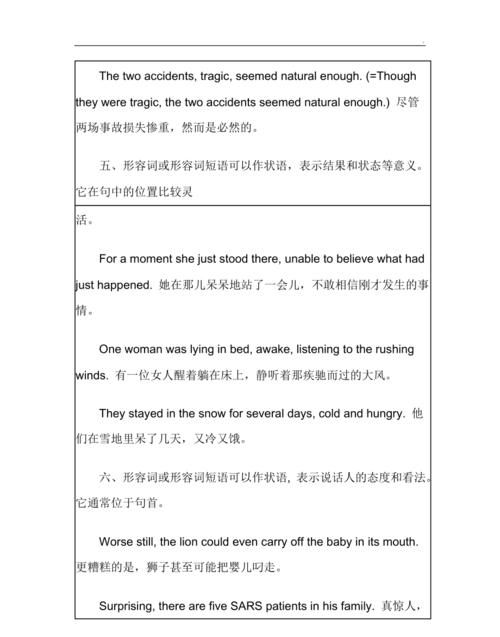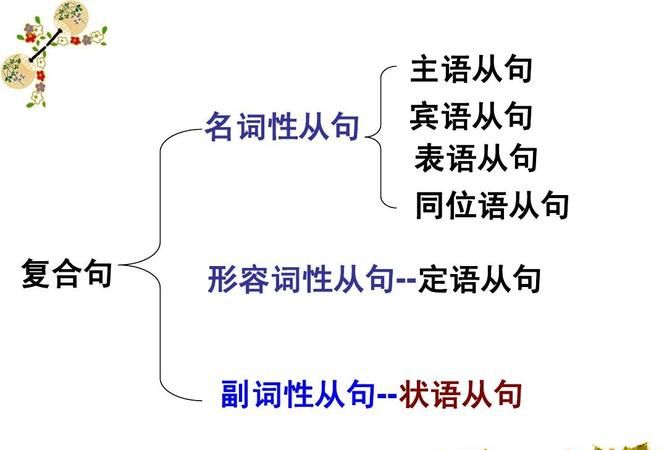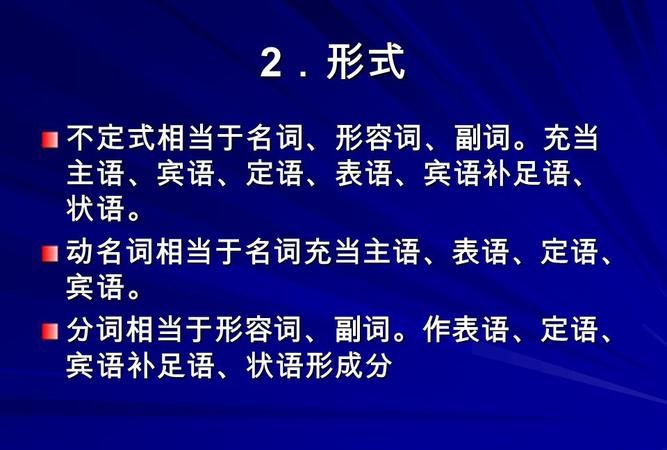本文目录
现代汉语中状语修饰形容词的例句
少数性质形容词能够直接修饰动词,作状语.例如:
你这样(乱)说.
这知识(难)学.
你(慢)走
咱们(细)想一下
他的远处(高)喊
这个问题(容易)把握
你要(正确)理解

形容词做状语的用法语文
形容词用作状语主要表示原因、结果或伴随等,其逻辑主语必须与句子主语保持一致。这类结构通常可用从句或并列句来改写:He came over, eager to help. / He came over and (he) was eager to help.他走过来,急于想帮忙。
形容词用作状语的三种类型
类型一:说明性状语
形容词的主要功能是用作定语和表语,但有时也可用作状语(有人也称之为主语补足语,因为它们是补充说明主语的)。如:
He lay in bed, awake. 他躺在床上,没有睡着。(表伴随)
He arrived home, hungry and tired. 他回到家里,又饿又累。(表结果)
Unable to afford the time, I had to give up the plan. 由于抽不出时间,我不得不放弃这个计划。(表原因)
形容词用作状语的特点是,该形容词的逻辑主语就是句子主语,并且通常可以用并列句或主从复合句来改写。如以上各句可改写为:
He lay in bed and he was awake.
He arrived home and he was hungry and tired.
Because I was unable to afford the time, I had to give up the plan.
类型二:程度状语
有少数形容词,如red, boiling, freezing, icy, bitter等,它们在某些搭配中可以起副词,用作状语,表示程度,意为“很”“非常”等。如:
The stove was red hot. 火炉是炽热的。
It’s boiling hot. 它是滚烫的。
His face was bright red. 他的脸是鲜红的。
The weather is freezing [icy, bitter] cold. 天气冷极了。
但这样的用法非常有限,并往往只用于某些特定搭配中,如可说 bitter cold(冰冷),bitter wind(寒风)等,但习惯上却不说 bitter hot(炽热),bitter busy(极忙)等。
类型三:承上启下性状语
有些形容词在某些固定结构中可用作独立成分,起承上启下的作用(也可视为一种状语)。如:
Sure enough, she was there. 果然她在那里。
Strange to say, he did pass his exam after all. 说也奇怪,考试他竟然通过了。
He may be late. Worse still, he may not come at all. 他可能会迟到。更糟的是,他可能根本不来。
More important, he’s got a steady job. 更重要的是他得到了一个稳定的工作。
Most remarkable of all, he never suffers from nerves on the stage. 最了不起的是他从不怯场。

形容词短语作状语英语经典例句
说是名词,其实多是名词词组,总结了一个下午,大致有以下几类,拿来和大家一同分享.
[1]名词或名词词组作状语,一般置于句末。
wait
a
minute.
等一会儿。
come
this
way!
走这边!
no
one
really
knows
why
wolves
walk
(in)single
file.排成一列行走。
[2]next/last/this/one/every/each/some/any/all+
day/month/year/sunday等等可以直接用作状语,有些已经演化成了固定短语如all
the
year
round一年到头
all
the
time一直
we
must
get
together
again
some
day.将来某天我们必能再相聚.
see
you
next
monday.
[3]一些由and或or连接所形成的名词短语如rain
or
shine和heart
and
soul等直接作状语
rain
or
shine,we
must
arrive
there
on
time.
we
should
serve
people
heart
and
soul.
[4]名词词组each/every/the
first/time,
the
instant/instance/moment/minute
所引导的时间状语从句;
the
way所直接引导的方式状语从句
例如:
you
see
the
lightning
the
instant
it
happens,
but
you
hear
the
thunder
later.
every
time
i
saw
him,
i
would
like
to
listen
to
his
songs.
i
came
to
the
house
the
moment
he
was
about
to
leave.

形容词做状语
形容词作状语主要表示原因、结果或伴随等。这类结构通常用从句或并列从句来改写如:He came over, eager to help。He came over and (he) was eager to help。他走过来,急于想帮忙。

说明性状语:形容词的主要是用作定语和表语,但有时也可用作状语(有人也称之为主语补足语,因为它们是补充说明主语的)。
如:He lay in bed, awake。 他躺在床上,没有睡着。(表伴随)。
He arrived home, hungry and tired。 他回到家里,又饿又累。(表结果)。
程度状语:有少数形容词,如red、 boiling、freezing、icy、bitter等,它们在某些搭配中可以起副词,用作状语,表示程度,意为“很”“非常”等。
如:The stove was red hot。火炉是炽热的。
Its boiling hot。它是滚烫的。
承上启下性状语:有些形容词在某些固定结构中可用作独立成分,起承上启下的作用。
如:Sure enough,she was there。果然她在那里。
Strange to say, he did pass his exam after all。说也奇怪,考试他竟然通过了。
以上就是关于形容词充当状语的例子 ,现代汉语中状语修饰形容词的例句的全部内容,以及形容词充当状语的例子 的相关内容,希望能够帮到您。

